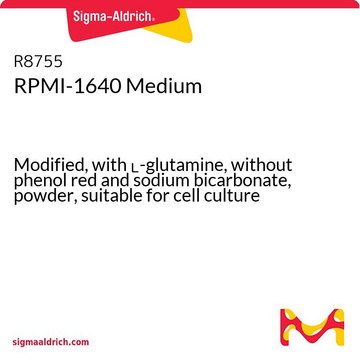R8005
RPMI-1640 Medium
Hybri-Max™, Modified, with L-glutamine, 4500 mg/L glucose and 15mM HEPES, without sodium bicarbonate, powder, suitable for hybridoma
Pharma Manufacturing
Synonym(s):
RPMI 1640 Culture Medium
Sign Into View Organizational & Contract Pricing
All Photos(1)
About This Item
Recommended Products
Quality Level
form
powder
technique(s)
cell culture | hybridoma: suitable
impurities
endotoxin
components
phenol red: 0.0053 g/L
L-glutamine: 0.3 g/L
HEPES: 3.5745 g/L
NaHCO3: no
glucose: 4.5 g/L (Dextro)
shipped in
ambient
storage temp.
2-8°C
Looking for similar products? Visit Product Comparison Guide
General description
RPMI 1640 Medium was developed at Roswell Park Memorial Institute in 1966 by Moore and his co-workers. A modification of McCoy′s 5A Medium, it was formulated to support lymphoblastoid cells in suspension culture, but it has since been shown to support a wide variety of cells that are anchorage-dependent. Originally intended to be used with a serum supplement, RPMI 1640 has been shown to support several cell lines in the absence of serum. It has also been widely used in fusion protocols and in the growth of hybrid cells. This medium is suitable for culturing human normal and neoplastic leukocytes.
Quantity
Formulated to contain 16.4 grams of powder per liter of medium.
Reconstitution
Supplement with 2.0 g/L sodium bicarbonate.
Legal Information
Hybri-Max is a trademark of Sigma-Aldrich Co. LLC
also commonly purchased with this product
Product No.
Description
Pricing
Storage Class Code
11 - Combustible Solids
WGK
WGK 2
Flash Point(F)
Not applicable
Flash Point(C)
Not applicable
Choose from one of the most recent versions:
Already Own This Product?
Find documentation for the products that you have recently purchased in the Document Library.
Customers Also Viewed
Michael D Lewis et al.
The American journal of tropical medicine and hygiene, 81(6), 1041-1049 (2009-12-10)
Trypanosoma cruzi, the agent of Chagas disease, can be subdivided into six discrete typing units (DTUs), TcI, TcIIa, TcIIb, TcIIc, TcIId or TcIIe, each having distinct epidemiologically important features. Dozens of genetic markers are available to determine the DTU to
Sven D Willger et al.
PLoS pathogens, 4(11), e1000200-e1000200 (2008-11-08)
At the site of microbial infections, the significant influx of immune effector cells and the necrosis of tissue by the invading pathogen generate hypoxic microenvironments in which both the pathogen and host cells must survive. Currently, whether hypoxia adaptation is
Ryoichi Arita et al.
Diabetes, 58(1), 215-226 (2008-10-09)
Leukocyte adhesion in retinal microvasuculature substantially contributes to diabetic retinopathy. Involvement of the Rho/Rho kinase (ROCK) pathway in diabetic microvasculopathy and therapeutic potential of fasudil, a selective ROCK inhibitor, are investigated. Localization of RhoA/ROCK and Rho activity were examined in
Fhernanda R Smiderle et al.
BMC complementary and alternative medicine, 11, 58-58 (2011-07-27)
Mushroom polysaccharides have traditionally been used for the prevention and treatment of a multitude of disorders like infectious illnesses, cancers and various autoimmune diseases. Crude mushroom extracts have been tested without detailed chemical analyses of its polysaccharide content. For the
Tamara Veiga-Parga et al.
PLoS pathogens, 7(12), e1002427-e1002427 (2011-12-17)
Ocular herpes simplex virus infection can cause a blinding CD4⁺ T cell orchestrated immuno-inflammatory lesion in the cornea called Stromal Keratitis (SK). A key to controlling the severity of SK lesions is to suppress the activity of T cells that
Our team of scientists has experience in all areas of research including Life Science, Material Science, Chemical Synthesis, Chromatography, Analytical and many others.
Contact Technical Service







